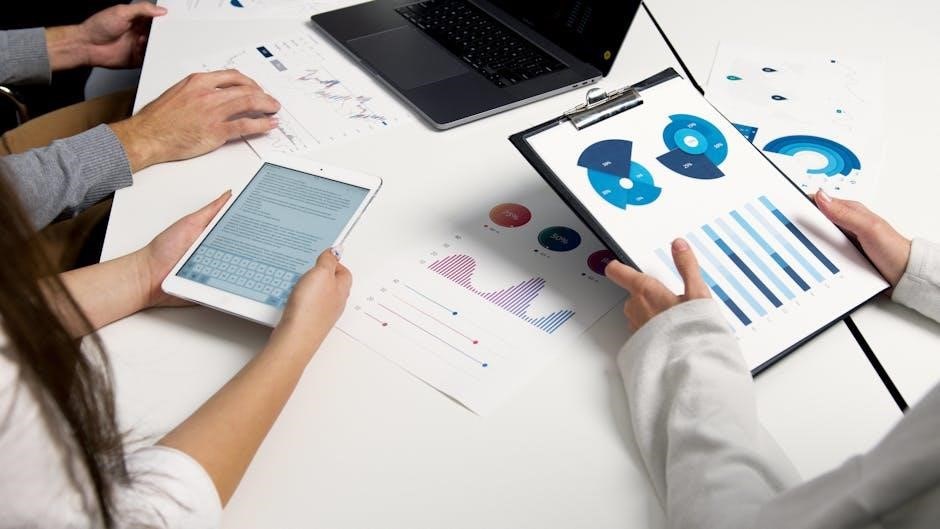The Global Technology Audit Guide provides a comprehensive framework for evaluating IT systems, ensuring compliance, and managing risks in an evolving digital landscape. It offers insights into aligning technology with organizational objectives, fostering innovation, and maintaining operational integrity across global markets.
1.1 Overview of Technology Audits
A technology audit is a systematic examination of an organization’s IT infrastructure, systems, and processes to ensure they align with business objectives. It evaluates hardware, software, data security, and compliance with regulatory standards. The audit identifies inefficiencies, risks, and opportunities for improvement, providing actionable insights to enhance performance, security, and operational efficiency. Regular audits are crucial for maintaining competitive advantage and adapting to technological advancements in a globalized business environment.
1.2 Importance of Global Technology Audits
Global technology audits are essential for ensuring organizational resilience, compliance, and optimal IT performance. They help identify and mitigate risks, enhance security, and align technology with business goals. Audits also ensure adherence to global regulations, fostering trust and accountability. By evaluating IT systems and processes, audits enable organizations to adapt to technological advancements, maintain competitiveness, and achieve sustainable growth in an increasingly interconnected world.
1.3 Scope and Objectives
The scope of the Global Technology Audit Guide covers evaluating IT infrastructure, assessing controls, and ensuring alignment with organizational strategies. Its primary objectives include identifying risks, ensuring compliance, and optimizing technology performance. The guide aims to provide a structured approach for auditors to evaluate systems, data security, and governance frameworks, fostering transparency and accountability while supporting business growth and innovation in a global context.

Key Components of IT Governance
IT governance involves leadership, frameworks, and policies ensuring IT aligns with organizational goals, manages risks, and optimizes performance through strategic planning and continuous improvement practices.
2.1 IT Governance Frameworks
IT governance frameworks, such as COBIT and ITIL, provide structured approaches to align IT strategies with organizational goals. They ensure effective management of IT resources, risks, and performance, fostering compliance and continuous improvement. These frameworks guide audits by establishing clear policies, roles, and processes, enabling organizations to optimize technology investments and achieve operational excellence while addressing regulatory and stakeholder expectations effectively.
2.2 Role of IT in Business Strategy
IT plays a pivotal role in shaping and executing business strategies by enabling efficient operations, driving innovation, and enhancing decision-making. It integrates key processes, supports digital transformation, and facilitates data-driven insights. Effective IT strategies align with organizational goals, ensuring scalability, agility, and competitive advantage. By leveraging technologies like ERP systems and digital marketing tools, IT empowers businesses to optimize performance, engage customers, and achieve sustainable growth in a rapidly evolving market landscape.
2.3 Aligning IT with Organizational Goals
Aligning IT with organizational goals ensures that technology strategies support overall business objectives. Effective IT governance frameworks help integrate technology with corporate aims, driving operational efficiency and innovation. By leveraging tools like ERP systems and digital marketing platforms, businesses can streamline processes and enhance decision-making. This alignment not only fosters growth but also ensures that IT investments yield measurable benefits, maintaining a competitive edge in the market.

Risk Assessment in Technology Audits
Risk assessment in technology audits identifies vulnerabilities and threats, ensuring compliance with regulatory standards and governance frameworks. It enables organizations to implement mitigation strategies and safeguard digital assets effectively.
3.1 Identifying Technology Risks
Identifying technology risks involves recognizing potential threats to IT systems and data integrity. Key risks include data breaches, system failures, and non-compliance with regulations like GDPR. Tools such as data analytics and audit software help detect vulnerabilities. Aligning IT strategies with organizational goals ensures effective risk mitigation. Early identification of risks is crucial for maintaining operational continuity and safeguarding digital assets, ultimately protecting the organization’s reputation and financial stability in a competitive market.
3.2 Assessing Risk Impact and Likelihood
Assessing risk impact and likelihood involves evaluating the potential consequences and probability of technology-related risks. This includes analyzing financial losses, operational disruptions, and reputational damage. Tools like data analytics and audit software help quantify risks, while likelihood assessment considers factors such as system vulnerabilities and threat frequency. Prioritizing risks based on their impact and likelihood ensures effective resource allocation and mitigation strategies, enabling organizations to address critical threats proactively.
3.3 Mitigation Strategies
Mitigation strategies involve implementing controls to reduce risk exposure. This includes deploying firewalls, encryption, and access controls to safeguard data. Regular audits and vulnerability assessments ensure compliance with standards like GDPR and ISO 27001. Training employees on security best practices and incident response plans further strengthens organizational resilience. Leveraging tools like AI and data analytics enhances monitoring and proactive threat detection, aligning with frameworks such as NIST to minimize risks effectively.

Compliance and Regulatory Requirements
Compliance with global regulations like GDPR and ISO 27001 ensures data privacy and security. Organizations must align IT systems with legal standards to avoid penalties and maintain trust.
4.1 Global Regulatory Landscape
The global regulatory landscape is complex, with varying laws across regions. Organizations must navigate GDPR, CCPA, and ISO 27001 to ensure compliance. These regulations focus on data privacy, security, and transparency. Non-compliance can lead to significant penalties. Understanding local and international standards is crucial for maintaining legal adherence and building trust with stakeholders. A structured approach to audits helps organizations align with these evolving requirements effectively.
4.2 Data Privacy and Security Standards
Data privacy and security standards are critical for safeguarding sensitive information. Regulations like GDPR and CCPA emphasize protecting personal data, while frameworks such as ISO 27001 provide guidelines for securing IT systems. These standards ensure confidentiality, integrity, and availability of data, mitigating cyber threats and breaches. Compliance with these standards is essential for maintaining trust and avoiding legal penalties in an increasingly regulated global environment.
4.3 Ensuring Compliance in Technology Systems
Ensuring compliance in technology systems involves implementing robust audit processes and adhering to regulatory frameworks. Tools like Qualtrics facilitate data collection and analysis, while SEO strategies optimize visibility. AI-generated content supports compliance by automating documentation. Regular audits, adherence to GDPR and CCPA, and leveraging frameworks like ISO 27001 ensure data integrity and security. These practices maintain operational trust and mitigate risks of non-compliance, fostering a culture of accountability and transparency in global technology systems.

Tools and Methodologies for Technology Audits
This section explores essential tools and methodologies for technology audits, including specialized software, data analysis techniques, and AI-driven solutions to enhance accuracy and efficiency.
5.1 Audit Software and Platforms
Audit software and platforms are critical tools for streamlining technology audits, offering features like automated scanning, compliance checking, and data analysis. Solutions such as Qualtrics, PeopleSoft, and ERP systems provide robust frameworks for managing audit processes. These platforms enable auditors to identify risks, track vulnerabilities, and generate detailed reports. Advanced tools also incorporate AI and machine learning to enhance accuracy and efficiency in evaluating IT systems and ensuring regulatory compliance.
5.2 Data Analytics in Auditing
Data analytics plays a pivotal role in modern auditing, enabling auditors to analyze large datasets for trends, anomalies, and risks. Advanced tools leverage machine learning and AI to identify patterns, predict outcomes, and enhance decision-making. By integrating analytics, auditors can assess compliance, detect fraud, and optimize processes. This approach ensures deeper insights, improved accuracy, and greater efficiency in evaluating organizational systems and alignment with regulatory standards globally.
5.3 Best Practices for Audit Execution
Effective audit execution requires meticulous planning, clear communication, and adherence to predefined objectives. Auditors should leverage technology tools to streamline processes and ensure data accuracy. Regular documentation and transparency in findings are essential. Collaboration with stakeholders fosters trust and ensures actionable insights. Continuous monitoring and adaptive strategies help address evolving risks. By following these practices, organizations can achieve comprehensive, efficient, and compliant audits that align with global standards and business goals.

Emerging Technologies and Their Impact
Emerging technologies like AI, blockchain, and cloud computing revolutionize audits by enhancing efficiency, transparency, and innovation. These advancements enable real-time data analysis, improved risk management, and compliance monitoring, ensuring audits adapt to evolving digital landscapes while maintaining integrity and accuracy.
6.1 Artificial Intelligence in Auditing
Artificial Intelligence (AI) is transforming the auditing landscape by automating repetitive tasks, enhancing data analysis, and improving accuracy. AI tools enable real-time insights, anomaly detection, and predictive analytics, reducing manual effort and increasing efficiency. By leveraging machine learning algorithms, auditors can identify risks and ensure compliance more effectively. AI also supports continuous auditing, allowing organizations to adapt to evolving regulatory and technological challenges, ensuring robust and dynamic audit processes.
6.2 Blockchain and Cybersecurity
Blockchain technology enhances cybersecurity by providing immutable and transparent transaction records, reducing fraud and data tampering risks. Its decentralized nature ensures data integrity, while smart contracts automate compliance checks. In audits, blockchain improves traceability and trust in digital systems. Integrating blockchain with cybersecurity frameworks strengthens data protection, ensuring resilience against evolving cyber threats and fostering a secure digital ecosystem for global organizations.
6.3 Cloud Computing and Its Risks
Cloud computing offers scalability and cost efficiency but introduces risks like data breaches, unauthorized access, and dependency on third-party providers. Auditors must assess cloud service providers’ compliance with data sovereignty laws and security standards. Additionally, risks such as vendor lock-in, downtime, and misconfigured systems pose challenges. Ensuring robust encryption, access controls, and regular audits is critical to mitigate these risks and safeguard organizational assets in the cloud environment.

Global Collaboration and Cultural Considerations
Global collaboration requires understanding cultural differences and cross-border regulations to ensure effective technology audits. Cultural awareness fosters stronger international teamwork and alignment with diverse organizational practices worldwide.
7.1 Managing Cross-Border Audits
Managing cross-border audits involves coordinating activities across jurisdictions, ensuring compliance with local regulations, and addressing cultural nuances. Auditors must navigate varying data privacy laws and language barriers while maintaining consistency in audit standards. Collaboration with local teams and leveraging technology tools can streamline the process, ensuring accurate and reliable outcomes in global audits.
7.2 Cultural Differences in Technology Adoption
Cultural differences significantly influence technology adoption, with regional norms, values, and user behaviors shaping implementation. Language barriers, local regulations, and varying levels of digital literacy also impact how technologies are perceived and utilized. Understanding these cultural nuances is crucial for auditors to ensure technologies align with local practices and user expectations, fostering successful adoption and compliance across diverse markets.
7.3 Collaborating with International Teams
Collaborating with international teams requires effective communication, mutual respect, and alignment on common goals. Tools like video conferencing and project management software facilitate teamwork across time zones. Understanding cultural differences and language barriers is essential for clear coordination. Regular updates, transparent workflows, and standardized processes ensure consistency. Building trust and fostering adaptability are key to successful global teamwork in technology audits.
The Global Technology Audit Guide underscores the importance of adapting to emerging technologies and fostering innovation. Future trends will focus on AI, blockchain, and cybersecurity advancements, reshaping audit practices and ensuring organizations remain competitive in a rapidly evolving digital world.
8.1 Summary of Key Findings
The Global Technology Audit Guide highlights the critical role of audits in ensuring digital transformation, risk management, and compliance. Key findings emphasize the importance of aligning IT with business goals, leveraging emerging technologies like AI and blockchain, and addressing cybersecurity threats. Organizations must adopt proactive strategies to navigate evolving regulatory landscapes and maintain operational integrity in a globalized digital ecosystem.
8.2 Evolving Role of Technology Audits
Technology audits are increasingly crucial as digital transformation accelerates, integrating AI, blockchain, and cloud solutions. They ensure organizations adapt to emerging risks and regulatory demands while maintaining operational resilience. The role now emphasizes proactive risk management, leveraging advanced analytics for real-time insights, and fostering collaboration between IT and business units to drive innovation and sustain compliance in a rapidly changing global landscape.
8.3 Preparing for Future Challenges
Organizations must stay ahead of rapid technological advancements and evolving risks. Preparing for future challenges involves upskilling audit teams, adopting advanced tools, and fostering global collaboration. Proactive strategies include leveraging AI, blockchain, and cloud solutions to enhance audit processes. Aligning IT strategies with business goals and complying with emerging regulations will be critical for maintaining resilience and driving sustainable growth in an increasingly complex digital environment.
